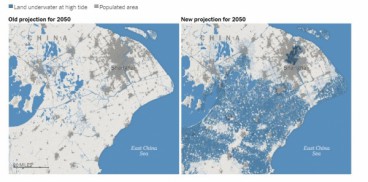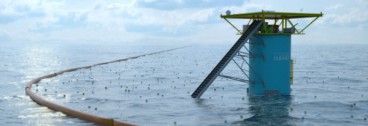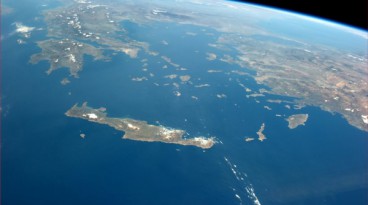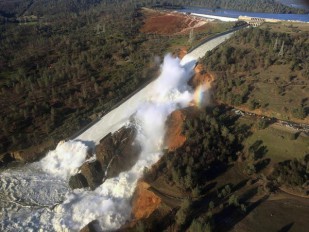Study quantifies human infrastructure on oceans for the first time

Scientists from Australia and the United Kingdom managed to quantify the manmade constructions that currently cover the world's oceans.
For the first time, infrastructure development in the oceans was quantified. The study was recently published in Nature Sustainability.
Oceans are covered by various infrastructure projects including wind farms, bridges, tunnels, ports, marinas, artificial islands, etc. According to the new findings, the total area that these facilities engulf is 30,000 square kilometers, about 20% of New York's state size.
In addition, if the total area of the oceans that has been affected by the infrastructure development is taken into consideration, there results show that around 2 million square kilometers or more than 0.5% of the oceans are impacted.
According to Dr. Ana Bugnot, lead author of the study and an expert on the effects of human impacts in the marine environment from the University of Sydney, establishing structures in ocean environment is not new since people have been building ports and other structures since ancient times. Nevertheless, marine construction has accelerated in modern times, a fact that has both its benefits and drawbacks.
“It has been ongoing since before 2000 BC. Then, it supported maritime traffic through the construction of commercial ports and protected low-lying coasts with the creation of structures similar to breakwaters. Since the mid-20th century, however, ocean development has ramped up, and produced both positive and negative results. For example, while artificial reefs have been used as ‘sacrificial habitat’ to drive tourism and deter fishing, this infrastructure can also impact sensitive natural habitats like seagrasses, mudflats and saltmarshes, consequently affecting water quality," Dr. Bugnot, stated.
The authors emphasize that infrastructure expansion predictions are concerning. According to Dr. Bugnot, marine construction is expected to increase by 50% to 70% in the next 8 years as there are numerous projects for energy and aquaculture. Both industries are very powerful and human civilization highly depends on them in terms of sustainability and financial prosperity.
The study suggests that coastal defense against sea-level rise will also significantly contribute to increasing the ocean infrastructure. In fact, many cities have future or on-going plans to tackle sea-level rise so that they won't submerge below water.
Collecting data and making reliable estimations is challenging since marine constructions' information is derived via private companies with little supervision. Therefore, scientists believe the current models that have been created may actually underestimate the extent of future marine construction expansion. "There is a dearth of information on ocean development, due to poor regulation of this in many parts of the world," Dr. Bugnot, mentioned.
Source: UniversityofSydney
Source: UniversityofSydney
Want to read more like this story?

The correlation between direct work and productivity in construction industry
Jul, 16, 2020 | NewsA new study focuses on a crucial relationship that impacts the construction industry. The correlatio...

New study suggests sea level rise will be much worse than anticipated
Nov, 18, 2019 | NewsNew evidence suggest that sea water level will rise much faster than anticipated and will soon affec...

A floating structure aims to pull plastic from the world’s oceans
Jun, 10, 2016 | NewsThe project’s next big target is the obliteration of the Great Pacific Garbage Patch The pr...

Different urbanization patterns in large cities worldwide
Oct, 23, 2020 | NewsA new study reveals dissimilar urbanization patterns in large cities all over the world during the p...

Horror Scenario For Coastal Areas
Jul, 29, 2015 | NewsClear warning from scientists, who note that the sea level rise may not be avoided even if the gover...

Impact of roadway infrastructure on human life risk
Oct, 25, 2019 | NewsA new study, published in Journal Accident Analysis & Prevention, focuses on the impact of roadw...

New study explains how global warming significantly increases the size of floods
Feb, 03, 2020 | NewsAccording to new research evidence, warming environment leads to more rainfalls and less snow accumu...

China’s massive infrastructure boost to tackle coronavirus crisis
Mar, 01, 2020 | NewsThe government of China plans a series of new infrastructure projects to boost the economy after the...

UN warns on the effects of sand dredging to the ocean floor and marine life
Sep, 05, 2023 | NewsThe UN Environment Programme (UNEP) warned on Tuesday about the impact that sand dredging has on th...
Trending

Vertical gardens in Mexico City to combat pollution

Saudi Park Closed After 360 Big Pendulum Ride Crashes to Ground, 23 injured

Characteristics of Load Bearing Masonry Construction

Taipei 101’s impressive tuned mass damper

Dutch greenhouses have revolutionized modern farming

Federal court rules Biden’s offshore drilling ban unlawful


